Fishing Nets in the Ocean: Impacts and Innovations
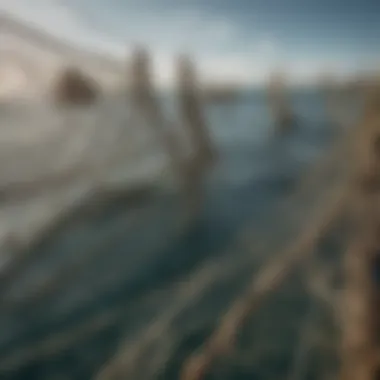
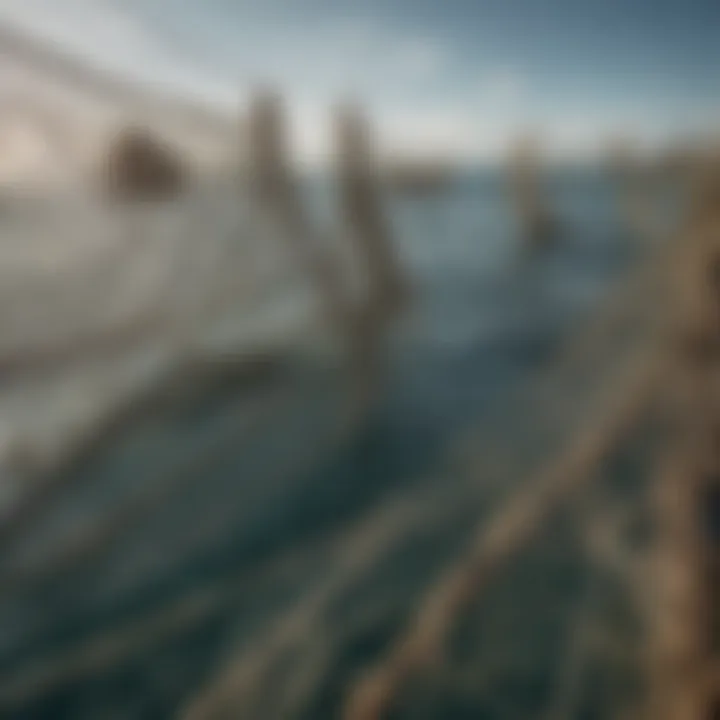
Intro
Fishing nets have long served as the backbone of the fishing industry, weaving a complex web between aquatic life and human livelihood. Their significance reaches far beyond a mere tool for catching fish; instead, they play multidimensional roles that touch on ecological balance, economic vitality, and the latest technological advancements in marine practices.
As various forms of fishing nets traverse the deep blue, their implications extend into the realms of marine conservation and sustainability. Understanding these nuances is vital for sports enthusiasts and adventure seekers alike. With the oceans facing unprecedented challenges due to overfishing, climate change, and plastic pollution, a deeper comprehension of fishing nets becomes essential. This piece aims to illuminate the diverse threads of impact woven by these nets in the great aquatic expanse.
"Fishing nets are not just threads in water; they thread humanity into the rhythm of the ocean's life."
This exploration will bring forth the intricate dynamics surrounding fishing nets in the ocean, shedding light on their environmental footprint, economic implications, and the innovative technologies paving the way for sustainable practices. Following this introduction, we'll delve into 'Techniques and Skills,' laying out both fundamental methods for beginners and advanced proficiencies for seasoned adventurers in the watersport world.
Overview of Fishing Nets
Fishing nets serve as essential tools in the fishing industry, playing a crucial role in not only the capture of aquatic life but also in shaping the environmental landscape of our oceans. Understanding fishing nets requires a close look at their definitions, purposes, and historical development, which collectively reveal their influence on marine ecosystems and the economy.
The importance of discussing fishing nets in this article rests on their dual nature. On one hand, they are indispensable for fishing communities and contribute significantly to global food security. Conversely, they pose various ecological challenges that can threaten biodiversity and marine health. With the rise of sustainable practices, it's clear that fishing nets symbolize both the potential for resourceful aquaculture and the need for careful management to mitigate their impact on the ocean.
Definition and Purpose
Fishing nets are devices made from woven fibers or materials, designed to entangle or impede aquatic life for capture. The fundamental purpose of these nets is straightforward: to gather fish and other marine creatures efficiently. However, their design and function can vary dramatically. For instance, gillnets are typically used to catch fish by their gills, while seine nets efficiently surround schools of fish, showcasing the array of techniques that fishermen employ.
The overarching aim of fishing nets is not just to harvest marine resources but to do so in a manner that balances economic gain with environmental stewardship. Their variable lengths, mesh sizes, and construction materials allow for specificity in targeting certain fish species, which directly relates to local fishing regulations and sustainability efforts. Fishing nets are, thus, at the intersection of tradition and technological advancement in the global fishing industry, setting the stage for debates about management and innovation in this crucial sector.
Historical Context
The historical use of fishing nets can be traced back to ancient civilizations, where early humans employed basic versions woven from natural fibers. These primitive nets were simple yet effective, demonstrating ingenuity in adapting to the natural world. Over centuries, net-making evolved with advancements in material science and techniques, leading to the diverse range of nets available today.
- Ancient Usage: Nets made from plant fibers, animal hides, and even early synthetic materials gave rise to diverse fishing methodologies across various cultures.
- Industrial Revolution: With the advent of the Industrial Revolution, mass production of fishing nets became possible. This shift allowed fishermen to increase their catch significantly but also laid the groundwork for overfishing in some regions.
- Modern Era: Today, fishing nets are produced using high-tech materials that promise strength and durability while responding to the pressing concerns about bycatch and ghost fishing. The reflection of historical progression in fishing nets underscores the need to adopt sustainable practices, ensuring that the legacy of fishing can continue for generations to come.
"Fishing nets have evolved from artisanal craft to industrial production, shaping both economies and ecosystems in profound ways."
Understanding these two subsections underlines why fishing nets are vital to this discussion—their definitions, purposes, and historical contexts provide clarity on their significance, balancing between utility and responsibility.
Types of Fishing Nets
Fishing nets play a crucial role in various fishing methods, each uniquely suited for specific environments and fish types. Understanding the types of fishing nets is not merely for the sake of knowledge; it’s essential for appreciating their implications on the economy, ecological challenges, and sustainable practices.
Different types of nets have been developed over time from simple trappings to complex systems. Each net serves specific purposes and has particular advantages, but they also come with considerations related to bycatch, efficiency, and environmental impact.
Gillnets
Gillnets are among the oldest fishing nets still in use today. Typically, they consist of a mesh net suspended vertically in the water. Fish swim into the net, and their gills become entangled. This method is particularly effective for species like salmon and herring.
One of the key benefits of gillnets is their adaptability. They can be designed to target specific fish sizes or species, reducing unwanted bycatch when properly managed. However, without careful monitoring, they can lead to overfishing and excessive bycatch, which poses a significant threat to marine ecosystems. Various regions have imposed regulations to mitigate these effects, highlighting the need for responsible fishing practices.
Trawls
Trawls are large nets towed through the water, catching fish from the ocean floor or the mid-water column. This method is effective for harvesting high volumes of fish quickly. Often used in commercial fisheries, trawls can target species like shrimp, cod, and haddock.
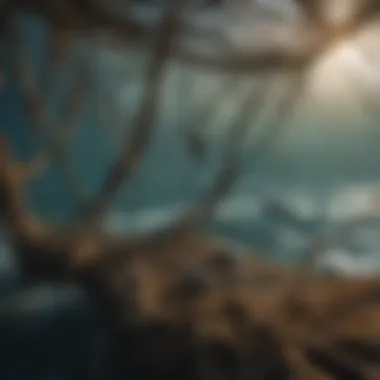

Despite their efficiency, trawls have drawn criticism due to their substantial environmental impact. The act of dragging the net can damage seabeds and result in significant bycatch, which can harm fish populations and other marine life. Addressing this issue has led to technological advancements, including the development of more selective trawl designs.
Seine Nets
Seine nets are another popular fishing tool, particularly in coastal areas. They consist of a long net with floats on the top and weights on the bottom, encircling schools of fish. Fishermen can pull the net closed, trapping the fish inside.
This method can be quite effective, especially for schooling species like menhaden or sardines. A significant advantage is that seine nets present lower risks of damaging habitats compared to trawling. Nevertheless, there is still concern about bycatch, and proper net depth and scale are necessary to minimize ecological harm. Fishermen often work collaboratively to develop strategies that ensure both efficiency and sustainability in their catches.
Cast Nets
Cast nets are smaller, handheld nets that are thrown by fishermen to catch fish close to the shore or in shallow waters. The net is designed to spread open upon landing in the water and then sink down to trap fish as it is retrieved. This method is favored by recreational and artisanal fishers for its simplicity and effectiveness in catching smaller species such as mullet and minnows.
Cast nets allow for selective fishing, making them a more sustainable choice when compared to larger nets. However, the skill level required for effective use means that not all fishermen can rely solely on this method. Furthermore, careful technique is essential to avoid disrupting local ecosystems or capturing juvenile fish.
In summary, understanding the various types of fishing nets unveils the complexities and intricacies of marine fishing practices. Each type has its advantages and potential pitfalls, highlighting the ever-important balance between effective fishing and marine conservation. As we progress to the ecological impacts of these nets, we will further explore the consequences of their use and the steps we can take to fish sustainably.
Ecological Impact
The ecological ramifications of fishing nets are wide-ranging and significant. While fishing nets play a critical role in supporting the industry and providing livelihoods, their influence extends deeply into aquatic ecosystems. Understanding these impacts is vital, not just for those in the fishing sector but also for conservationists and policy makers who aim to strike a balance between resource utilization and environmental health.
Bycatch and Its Consequences
Bycatch refers to the unintended capture of non-target species while fishing. This issue poses a substantial threat to marine life, contributing to the decline of many fish populations and other aquatic creatures. The reality is that numerous species end up entangled in nets designed for a specific catch. For instance, dolphins, sea turtles, and even seabirds may find themselves caught in gillnets meant for fish, leading to injury or death.
"Bycatch can surpass the targeted catch in some fisheries, creating an unsustainable cycle that undermines marine biodiversity."
This unwanted catch isn’t just an environmental concern; it has socio-economic implications too. Fishermen often face decreased catches of their intended species due to overfishing and ecological disturbances. When bycatch management isn’t in place, it leaves a negative impact on many levels, including food security and marine resource availability. Tackling this challenge requires innovative solutions, such as bycatch reduction devices and stricter regulations to ensure that bycatch is minimized.
Ghost Fishing
Ghost fishing is another grim aspect of fishing nets. It occurs when lost or abandoned nets continue to trap and kill marine life for years after being discarded. These "ghost nets" can create hazardous situations for a multitude of species, often leading to prolonged suffering or death. This phenomenon raises serious questions about the sustainability of fishing practices.
In recent years, initiatives seeking to recover ghost nets have gained traction, with various organizations advocating for clean-up projects. However, awareness still needs to spread. Fishermen can help by reporting lost gear and participating in recovery programs.
Impacts on Biodiversity
The impact of fishing nets on biodiversity can not be overlooked. Various species rely on healthy ecosystems for survival, and the introduction of fishing nets with harmful practices can lead to the destruction of habitats. As certain species are depleted, it disrupts the entire food chain, causing a domino effect.
- Habitat destruction: Trawling can scrape the ocean floor, destroying coral reefs and the homes of many marine animals.
- Species decline: Unsustainable fishing practices can lead to the extinction of vulnerable species, which consequently further jeopardizes ecological balance.
- Cost of recovery: The time and resources needed to restore ecosystems devastated by fishing practices can be substantial and often take decades.
The concern over declining biodiversity has spurred calls for more responsible fishing practices. Advocating for sustainable designs and fishing techniques can bridge the gap between economic needs and ecological preservation.
In summary, the ecological impact of fishing nets extends beyond water surface to the intricate web of marine life and their habitats. As we recognize these impacts, it becomes clear that innovative, sustainable strategies must be employed to preserve the oceans and ensure the health of our fishing industries.
Economic Significance of Fishing Nets
Fishing nets play a crucial role in the global economy, influencing various aspects of the fishing industry, from local livelihoods to international trade. Their ability to facilitate the capture of fish not only sustains communities that rely on fishing for their subsistence but also bolsters economies on a larger scale. An in-depth understanding of this economic significance reveals how fishing nets are intertwined with environmental sustainability and global market dynamics.
Contribution to the Fishing Industry
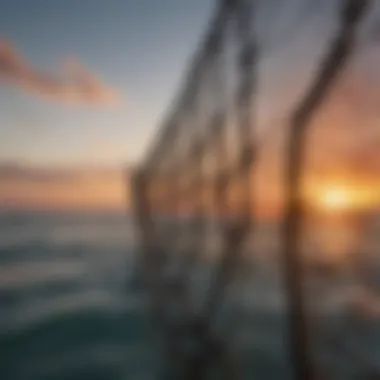
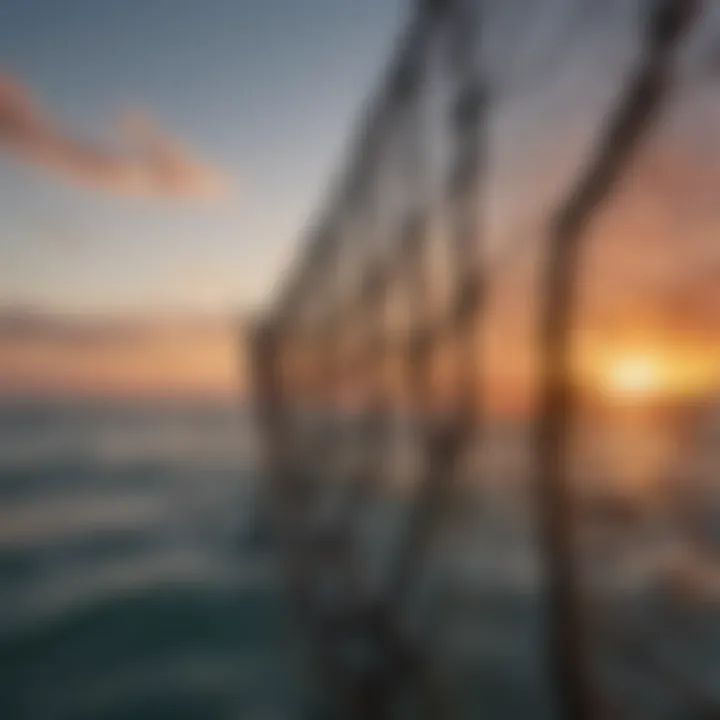
Fishing nets are the backbone of the fishing industry. They provide the means for fishermen to catch a variety of marine species, contributing to both subsistence and commercial fishing. For over centuries, nets have been evolving in design and materials, enabling fishermen to increase their catch efficiency. The ability to tailor nets for specific fish populations has led to more sustainable fishing practices, which are increasingly necessary in today’s changing marine environments.
- Job Creation: The fishing net sector alone creates thousands of jobs, from fishing to net production, maintenance, and innovation. This industry supports a plethora of occupations, which range from the fishermen working in the waters to the manufacturers churning out nets for diverse usages.
- Revenue Generation: The commercial fishing industry generates billions of dollars annually. Nets are instrumental in capturing fish that are then sold in local, national, and international markets. This revenue flow not only feeds families but also supports entire economies.
- Supporting Local Economies: In coastal communities, fishing nets allow families to sustain their livelihoods. Money earned from fish sales helps keep local businesses afloat and ensures that money remains circulating within the community.
Fishing nets, therefore, are not just tools; they are economic lifelines. By enabling a sustainable harvest of marine life, they help balance fishing practices with the necessity of ebrochering economic stability in vulnerable communities.
Global Trade Dynamics
The fishing net industry is intricately connected to global trade. Fish caught using various types of nets are frequently exported and traded, making fishing nets a hidden cog in the wheels of international commerce.
- Import and Export Markets: Countries around the world engage in the trade of fish, with the fishing nets determining what species can be caught and in what quantities. Nations with rich fishing grounds often export their catches to countries with high demand.
- Price Influences: The availability and regulation of certain fish species influence market prices. Fishing nets that comply with sustainable practices help secure higher prices. Buyers are increasingly looking for responsibly sourced seafood, thereby affecting the economics of fishing gear production.
- Regulatory Impacts: Trade agreements and regulations on fishing practices vary from country to country. Nations that enforce strict environmental regulations may see a market advantage, promoting product differentiation in terms of sustainability and responsible fishing practices.
These dynamics illustrate that fishing nets do not exist in isolation. They are a part of a larger economic ecosystem where local practices ripple through to global marketplaces, ultimately affecting pricing, sustainability, and the future of marine resources.
By understanding the economic significance of fishing nets, stakeholders can make informed decisions about sustainable practices and policies, ensuring a balance between harvesting and conservation.
Technological Advances in Fishing Nets
Technological advancements have revolutionized the fishing industry, particularly in fishing nets. These innovations not only enhance efficiency but also address pressing ecological concerns. The integration of technology into net design and deployment provides significant benefits—leading to reduced bycatch, minimized ecological impact, and improved data collection. In a world where conservation and sustainable practices are paramount, understanding these advancements is crucial for anyone involved in fishing or marine exploration.
Smart Nets and AI Integration
As we step into an era where smart technology infiltrates every aspect of our lives, fishing nets have not been left behind. Smart nets, equipped with sensors and artificial intelligence, are transforming traditional fishing practices. These nets can adapt to environmental conditions, automatically adjusting their depth or the size of their openings based on target species behavior.
For instance, some smart nets utilize GPS and sonar technology to locate fish more accurately. These features allow fishers to capture desired species while avoiding non-target species, reducing bycatch significantly. By employing machine learning algorithms, smart nets can also gather data about fish populations, helping scientists understand migratory patterns and population dynamics.
"The future of fishing nets is here, where technology meets sustainability to create a better oceans for all."
Moreover, the real-time data collected by AI-integrated nets offers valuable insights into ocean health. As permit regulations become stricter, these nets provide fishers with necessary compliance information, ensuring that practices align with sustainability goals. Not only do these nets offer practical solutions, but they also create a robust framework for responsible fishing that can be adapted as environmental policies evolve.
Materials and Design Innovations
The materials used in fishing nets have undergone a dramatic shift as manufacturers seek to balance functionality with sustainability. Innovations such as biodegradable nets made from natural fibers reduce the long-term environmental impact. These nets break down over time, mitigating the issue of ghost fishing, where discarded nets continue to trap marine life.
Additionally, synthetic materials such as high-durability polyethylene and advanced composites have been developed to increase the lifespan of fishing nets. These modern materials are lightweight yet robust, making them easier to handle while also resisting degradation from exposure to saltwater and UV rays.
Key design innovations include:
- Multi-layer nets: These nets incorporate various mesh sizes in a single structure, enabling fishers to target different species at various depths without changing equipment.
- Zippered net openings: This design feature allows for easier release of non-target species, promoting catch and release practices.
- Colored nets: Color-coded nets help in minimal visibility under water, ensuring fish are less likely to see them, thereby improving catch rates.
The advancements in both materials and designs reflect a growing recognition of the need for sustainable fishing practices. As the industry moves forward, adopting these innovations will play a pivotal role in maintaining marine ecosystems while still providing economic benefits to fishing communities.
Sustainable Fishing Practices
Sustainable fishing practices are pivotal in the discourse surrounding fishing nets in our oceans. As society becomes increasingly aware of the necessity for ecological balance, these practices serve as a bridge between the demands of commercial fishing and the protection of marine ecosystems. By implementing sustainable methods, the fishing industry can ensure that it meets the needs of today without compromising the wellbeing of future generations.
Regulations on Net Usage
One significant pillar of sustainable fishing practices lies in the regulations surrounding net usage. Various legislations have emerged globally to address the pressing concerns related to overfishing and habitat destruction. These regulations often include restrictions on the size, type, and area where specific fishing nets can be deployed. For instance, the European Union enforces strict rules on mesh sizes to reduce bycatch—a concern where non-target species are unintentionally captured.
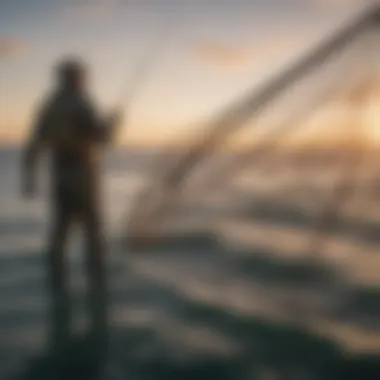
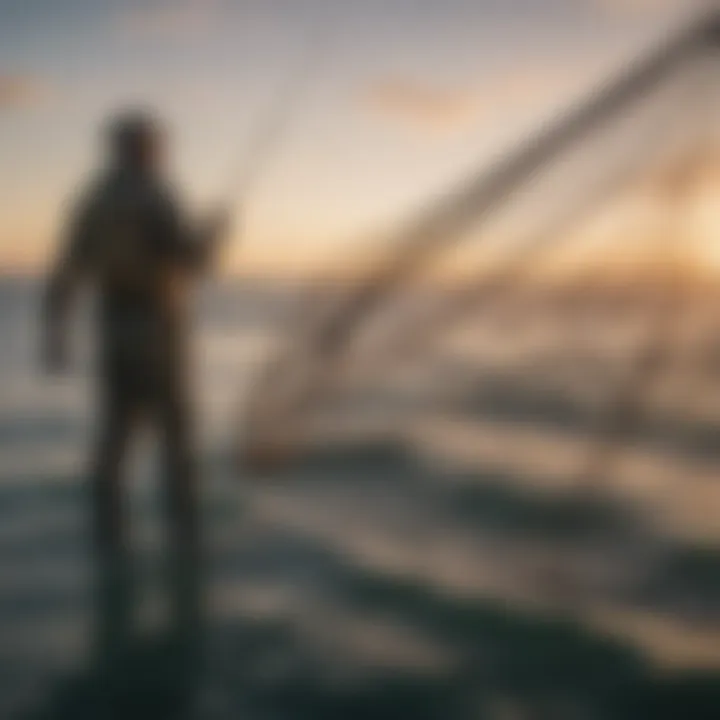
Moreover, compliance with these regulations not only helps preserve biodiversity but also holds economic benefits for fishing communities. By establishing sustainable practices, they secure the ongoing productivity of fish stocks, ensuring their livelihoods in the long run. Fishermen who abide by these rules can sometimes access premium markets that value sustainability, which can be a significant boon. Individuals involved in fishing must remain educated about these regulations, which can vary widely from region to region.
Net Recycling Initiatives
Another essential aspect of sustainable practices involves the recycling of fishing nets, which is increasingly recognized as a viable solution to tackle plastic pollution in oceans. Many fishing nets are made of synthetic materials that can take hundreds of years to decompose. As a result, discarded nets contribute to the growing problem of ocean debris, further exacerbating the issue of ghost fishing—where lost nets continue to trap marine life.
Innovative initiatives have emerged to address this concern. Organizations are spearheading programs that repurpose discarded fishing nets into new products, ranging from recycled materials for construction to stylish outdoor gear. Companies like Net-works have developed strategies to gather, recycle, and transform old nets into usable fabrics, fueling both an eco-friendly mission and creating financial incentives for fishermen to return their nets rather than tossing them.
"By recycling fishing nets, we aren’t just cleaning up the oceans, we’re creating a circular economy that benefits local communities and ecosystems alike."
In addition, programs that educate fishermen on the importance of proper disposal methods are paramount. These practices not only promote environmental responsibility but can lead to tangible economic gains through incentives offered for returning old nets.
Both regulations on net usage and net recycling initiatives are vital cornerstones of sustainable fishing practices that land and sea enthusiasts should be acutely aware of. Education and proactive engagement in these practices are essential for the present and future health of our oceans.
Future Trends in Fishing Nets
Fishing nets serve as an essential tool in the restoration and maintenance of our marine environments. As we move further into the 21st century, the focus shifts toward future trends that shape these tools and their impact on the oceans. This section investigates legislative changes and innovative solutions that emerge in response to growing ecological awareness and technological advancements. The integration of these elements will be pivotal in defining sustainable fishing practices while ensuring the continued viability of fisheries.
Evolving Legislation and Environmental Policies
Legislation regarding fishing nets is evolving in a way that aims to reduce environmental degradation and encourage sustainable practices. Governments and international bodies are reevaluating the current frameworks that regulate fishing activities. Regulations are becoming more stringent as awareness of the adverse effects of overfishing and net-related pollution rises. Some key aspects of evolving legislation include:
- Restrictions on certain types of nets: As bycatch and ghost fishing become more pressing issues, some jurisdictions have started to ban or limit the use of specific net types. This includes the outright banning of destructive gillnets in sensitive ecosystems.
- Mandatory reporting and monitoring: Fishermen may be required to report their catches more accurately, increasing transparency and minimizing illegal fishing activities. This not only helps in conserving fish populations but also ensures a fair playing field for all fishers.
- Incentives for sustainable practices: Governments might offer incentives for fishers who adopt eco-friendly gear and fishing methods. These can come in the form of subsidies, grants, or even tax breaks, encouraging more fishers to go green.
Legislation is merely a starting point. Awareness campaigns about the legislation and their implications play a critical role in ensuring compliance from the fishing community.
Innovative Solutions for Conservation
Innovative solutions for conservation highlight the intersection of technology and environmental stewardship in the fishing industry. As challenges mount, the quest for more sustainable practices has inspired creativity among industry stakeholders. Some noteworthy innovations include:
- Smart fishing nets: Integration of sensor technology allows fishers to monitor the targeted species, automatically closing nets when unwanted species are detected. This reduces bycatch significantly and promotes responsible fishing.
- Biodegradable nets: Such nets are designed to break down in the environment, reducing the risk of ghost fishing. Materials like biopolymers are being researched and developed, offering viable alternatives without sacrificing performance.
- Community-based management: Collaborative efforts between local fishers, conservationists, and policymakers are yielding tailor-made solutions that reflect the unique biodiversity and ecological needs of an area. This localized approach helps empower communities and ensures joint ownership of conservation goals.
"Innovative solutions don't just benefit the environment; they also ensure the economic viability of fishing practices in the long run."
The landscape of fishing is rapidly shifting. By staying attuned to these future trends, stakeholders can seek a balance between economic interests and ecological resilience. As the saying goes, "You reap what you sow," and this couldn't be truer when considering the implications of fishing nets in our oceans.
Epilogue
The conclusion of this article serves as a crucial focal point that ties together the various threads woven throughout the discussion on fishing nets in the ocean. It’s not just about summing up information; it's about emphasizing the relevance of the insights gathered—from the diverse types of fishing nets and their ecological impacts to the economic implications and technological advancements. By highlighting these elements, readers can appreciate the intricate balance between efficient fishing practices and the essential need for marine conservation.
Summary of Key Insights
In this exploration, several key insights emerge that are essential for both enthusiasts and practitioners in the marine realm:
- Variety of Nets: Different types of fishing nets, such as gillnets and trawls, serve unique purposes. Understanding these distinctions is vital for making informed decisions in both usage and conservation efforts.
- Ecological Concerns: The issue of bycatch and ghost fishing has far-reaching implications on marine biodiversity. Recognizing this can drive home the importance of responsible fishing practices.
- Economic Value: Fishing nets play a significant role in the livelihood of countless individuals and communities. This economic perspective cannot be overlooked when discussing sustainable practices.
- Sustainability Initiatives: Innovations in net design and recycling programs highlight the ongoing efforts to minimize negative impacts on the ocean. Awareness of these initiatives can inspire further action.
Understanding these points can inspire individuals and industries alike to work towards a sustainable future for ocean fishing.
Call to Action for Sustainable Practices
With the insights gained, it’s imperative for everyone involved in marine activities to push for sustainable practices. Here are some actionable steps to consider:
- Educate and Advocate: Share knowledge about the ecological impacts of fishing nets with peers and community members. Awareness can drive change.
- Support Regulations: Engage with policies that aim to reduce bycatch and promote responsible net usage. This could mean supporting local regulations or advocating for international agreements that safeguard marine biodiversity.
- Choose Sustainable Products: Whenever possible, opt for fishing nets that are made from sustainable materials or are designed to minimize environmental harm. A conscious choice can go a long way.
- Participate in Cleanup Initiatives: Join or organize efforts to remove plastic and abandoned fishing nets from oceans and beaches. Small actions can lead to significant improvements over time.
- Stay Informed: Keep abreast of innovations in fishing technology aimed at conservation. Knowledge could provide numerous opportunities for positive change within the community.
By committing to these actions, we can all contribute to the preservation of our oceans and the sustainability of fishing practices for future generations. It’s a delicate balance that requires everyone’s input and effort.







